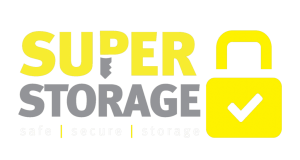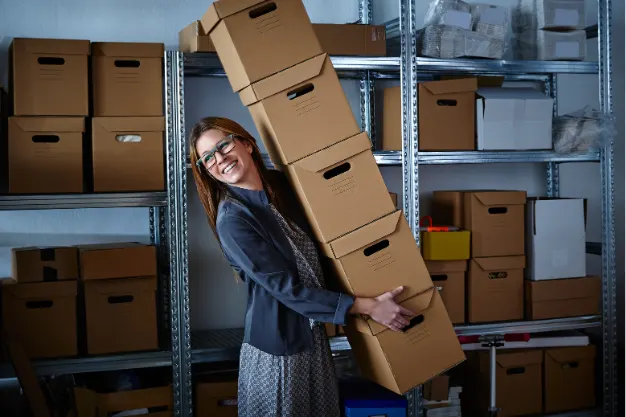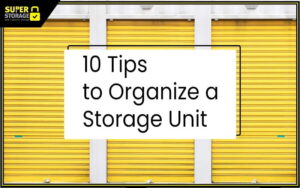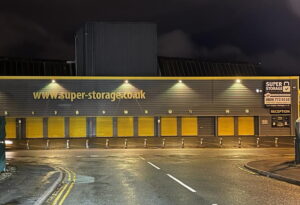Most people rent a storage unit with the hope of keeping their belongings safe and organised. Yet, the reality is often different: boxes pile up, items get damaged, and valuable floor space goes unused. Studies show that the average person only uses around 60% of their storage unit space effectively, which means a large portion of the unit is wasted.
The good news? With the right shelving strategies, storage units can be transformed into efficient and accessible spaces. Strategic shelving can nearly double storage capacity, ensuring every square foot counts.
This complete guide to storage unit shelving tips in 2025 will explore shelving solutions, DIY ideas, space maximisation hacks, and organisation systems that can help anyone make the most out of their storage unit. Readers will also discover budget-friendly options, portable shelving ideas, and practical advice for maintaining accessibility and protecting belongings.
Why Proper Shelving Matters in Storage Units
When renting a storage unit, most people imagine it will be a neat space. In reality, without proper shelving, belongings often end up piled high in an unstable and unsafe way. This not only wastes valuable space but can also put items at risk. Proper shelving transforms a cramped and messy unit into an efficient, easy-to-use storage system.
One of the biggest benefits is the ability to maximise vertical space utilisation. Storage units are usually taller than they are wide, which means shelves allow every inch to be used from floor to ceiling. Instead of leaving large gaps, vertical shelving creates multiple layers of organised storage.
Shelves also protect items from floor moisture and pests. Placing boxes and valuables directly on the ground exposes them to dampness, accidental spills, and unwanted insects. Raised shelving acts as a safety barrier, ensuring belongings remain in good condition.
Another key advantage is improved accessibility and organisation. Instead of digging through stacks of heavy boxes, shelves allow everything to be clearly visible and easy to reach. This reduces the risk of damage from stacking heavy items on top of fragile ones.
Finally, shelving leads to cost savings through better space efficiency. By doubling usable capacity, renters may be able to downsize to a smaller unit and save money each month.
For example, a 10×10 storage unit filled with random boxes stacked on the floor. Because of uneven box sizes and wasted gaps, only about 60% of the available space is actually used. After adding tall metal shelving along the walls, those same boxes can be stacked securely up to the ceiling, freeing up the middle of the unit for larger items like furniture or bicycles. With shelving, the usable capacity jumps to nearly 90–95%, meaning the renter can fit almost double the belongings in the same unit.
Types of Storage Unit Shelving Systems
Choosing the right shelving can completely change how a storage unit works. With the right system, belongings stay safe, space is maximised, and accessibility is much easier. There are three main types of storage unit shelving systems: wire, metal/steel, and plastic. Each has its strengths and drawbacks, so the best choice depends on what items are being stored and the budget available.
- Wire Shelving Units
Wire shelving is one of the most popular storage shelving solutions because it’s lightweight, easy to assemble, and allows air to circulate stored items. This circulation helps reduce the risk of mould or damp, especially in units without climate control. Many wire shelving systems are also rust-resistant, which adds to their lifespan.
- Pros: Lightweight, breathable design, rust-resistant.
- Cons: Small items may slip through the gaps unless stored in bins.
- Best for: Clothing, linens, and medium-sized boxes.
- Price range: Around £30–£80 per unit.
Wire shelving storage units are excellent for anyone wanting an affordable yet reliable option for lighter household goods.
- Metal/Steel Shelving
For those who need strength and durability, metal shelving units are the best option. They are designed for heavy-duty use and can handle large, bulky items without bending or collapsing. Many models are adjustable, making it easy to customise shelf heights for different storage needs.
- Pros: Strong, durable, adjustable heights.
- Cons: Heavier to move, usually more expensive.
- Best for: Tools, books, furniture pieces, and heavier boxes.
- Price range: Typically £50–£150 per unit.
These shelves are perfect for anyone needing a long-lasting solution that supports large loads, making them ideal in both storage facilities and home garages.
- Plastic Shelving
Plastic shelving is a simple and affordable option, especially for those on a budget. It’s moisture-resistant and very lightweight, which makes it easy to move around or reconfigure. However, it has a lower weight capacity compared to wire or steel options.
- Pros: Moisture-resistant, lightweight, budget-friendly.
- Cons: Not suitable for very heavy items.
- Best for: Seasonal decorations, sports gear, and garage items.
- Price range: Roughly £25–£60 per unit.
Plastic shelving works well for lighter loads and offers a practical choice for people looking for cheap storage unit shelving options without compromising basic organisation.
By mixing different shelving systems, renters can design a customised setup that balances strength, flexibility, and affordability. This approach ensures every type of item, from fragile decorations to heavy tools, has a safe and efficient place within the storage unit.
Essential Storage Unit Shelving Tips for 2025
The secret to making the most out of a storage unit isn’t just about the type of shelves you buy; it’s about how you use them. With the right storage unit organisation tips, belongings can be kept safe, space can be doubled, and retrieving items becomes effortless. Below are practical strategies designed for 2025 to help renters achieve a perfectly organised and efficient storage unit.
- Plan Your Layout First
- Measure the storage unit dimensions – Get accurate length, width, and height measurements before purchasing shelves.
- Sketch a simple floor plan – Draw out the unit on paper or use a digital tool to visualise the layout.
- Mark shelf positions – Decide where shelves will be placed, making sure they fit properly without blocking doors or corners.
- Leave access paths – Keep enough space for a walkway so you can move around easily. Aim for at least 3 feet down the centre.
- Consider the door swing – Ensure shelving isn’t placed too close to the entrance, as it may block the door when opening.
- Group belongings by category – Create zones for different types of items (e.g., household goods, seasonal decorations, tools, documents).
- Plan for future additions – Leave some free space for new items so you don’t need to rearrange everything later.
- Maximise Vertical Space
- Choose tall shelving units – Opt for shelves that are 6–8 feet high (if ceiling allows) to take full advantage of vertical storage.
- Install shelves close to the ceiling – Place the top shelf as high as possible, while leaving enough space for ventilation and safety.
- Leave 18 inches from the ceiling – This ensures proper airflow and complies with most storage facility fire regulations.
- Use stackable storage bins – Store smaller items in bins that fit neatly on shelves, preventing wasted gaps.
- Combine shelves with vertical storage systems – Add hooks or hanging racks for lightweight items like tools or sports gear.
- Create Zones for Different Items
- Heavy items on bottom shelves – Keeps the unit stable and reduces the risk of accidents.
- Frequently accessed items at eye level – Place things you’ll need most often where they’re easiest to grab.
- Seasonal items on top shelves – Christmas decorations, camping gear, or winter clothing can be stored higher up.
- Fragile items in protective containers – Use sturdy storage bins and keep them on middle shelves where they’re safe from crushing.
- Organise by category – Assign each section of shelving to a type of belonging, creating an easy-to-follow organisation system.
- Ensure Easy Access
- Leave a central walkway – Keep at least 3 feet of space down the middle of the unit for movement.
- Position shelves along walls – This maximises space while keeping the centre clear.
- Face all labels outward – Makes identification faster and avoids unnecessary lifting.
- Use clear storage bins – Transparent bins let you see contents at a glance without opening each box.
- Keep an inventory list near the entrance – Note the location of key items to avoid searching through the whole unit.
- Store portable storage shelves strategically – Use them for items you may need to move around more often.
By combining these essential storage unit shelving tips with the right shelving systems, renters in 2025 can make the most of their units. From maximising vertical space to creating easy-access zones, every strategy works together to enhance both efficiency and peace of mind.
DIY vs Pre-Made Shelving Solutions

When deciding between DIY storage unit shelving ideas and pre-made systems, here are the main considerations:
DIY Options
- Cinder Blocks and Boards – A budget-friendly option where wooden planks are balanced on cinder blocks to create makeshift shelves. Works well for lightweight items but isn’t suitable for very heavy loads.
- PVC Pipe Shelving – A creative, low-cost solution for lighter belongings. PVC frames can be cut to size and adjusted as needed. Ideal for short-term storage.
- Pros: Cheap, flexible, and easy to customise to fit odd-sized units.
- Cons: Time-consuming, less durable, and requires careful assembly for safety.
Pre-Made Shelving Solutions
- Wire Shelving Storage Units – Affordable, lightweight, and breathable. Perfect for boxes, linens, and clothing.
- Metal Shelving Units – Strong and long-lasting, ideal for tools, heavy books, and bulky items.
- Plastic Shelving – Lightweight, moisture-resistant, and easy to move. Best for seasonal decorations or sports equipment.
- Pros: Quick assembly, warranties available, professional look.
- Cons: Higher cost compared to DIY.
Cost & Time Investment
- DIY: Low cost (£15–£40) but higher time and effort.
- Pre-made: Higher cost (£30–£150 per unit) but saves time and offers more durability.
When to Choose Each
- DIY Shelving: Best for tight budgets, temporary storage, or creative custom setups.
- Pre-Made Shelving: Ideal for long-term use in a storage facility, where safety, stability, and storage accessibility matter most.
Safety Considerations for DIY
- Always check the weight limits of DIY shelves.
- Avoid using untreated wood or unstable materials.
- Make sure DIY racks are balanced and level to prevent accidents.
Installation and Safety Tips
Before installing any storage unit shelving systems, follow these guidelines:
- Check Facility Rules – Some facilities restrict permanent fixtures such as wall anchors. Always confirm what’s allowed.
- Wall Anchors – If permitted, use proper anchors for the wall material to stabilise shelves.
- Level and Stability – Ensure all storage racks are balanced to prevent tipping.
- Weight Distribution – Heavy items on the bottom, lighter ones on top. This protects both shelves and stored items.
- Earthquake/Movement Safety – In areas prone to vibration or movement, use straps or braces to secure tall shelves.
- Tool Requirements – Basic tools such as screwdrivers, spanners, and rubber mallets are usually enough for assembly.
- Portable Storage Shelves – These are easier to install since they often don’t require wall anchors, making them great for renters.
Common Mistakes to Avoid
Many people unintentionally waste space or damage items in their units. Avoid these mistakes:
- Overloading Shelves – Exceeding weight limits can cause shelves to collapse, damaging belongings.
- Blocking Access – Storing frequently used items at the back makes retrieval stressful. Keep them at the front or at eye level.
- Ignoring Climate Control – Delicate belongings like books, electronics, or wooden furniture need protection in climate-controlled units.
- Poor Ventilation – Not leaving space between the top of shelving and the ceiling blocks airflow, leading to mould or damp.
- Wrong Shelving Choice – Using plastic shelving for heavy tools or metal shelving units for fragile ornaments reduces effectiveness.
- No Labels – Forgetting to label boxes or bins makes finding items difficult and wastes time.
Clearly makes retrieval frustrating. By avoiding these pitfalls, anyone can keep their unit safe, efficient, and well organised.
Conclusion & Next Steps
Proper shelving is the single most effective way to transform a cluttered unit into a neat, safe, and efficient space. From storage shelving solutions like wire shelving, storage units, and metal shelving units, to budget-friendly plastic shelving and portable storage shelves, the right choice can make all the difference. By following these storage unit shelving tips, renters can enjoy better storage space maximisation, improved organisation, and easier access to their belongings.
The first step is simple: measure your unit, plan your layout, purchase the right self-storage shelving system, and install it carefully. Even starting with one section can create noticeable improvements, and over time, expanding shelving across the unit will deliver maximum benefits.
For those seeking professional support, Super Storage facilities offer secure spaces with features that make it easier to implement these shelving strategies. They provide the perfect foundation for maintaining order while keeping your belongings safe and accessible.
Begin small, stay organised, and soon every inch of your storage unit will work harder for you.
Frequently Ask Question
What are the best shelving tips for small storage units in 2025?
The best shelving tips include using vertical racks, adjustable shelves, and labelled containers to maximise small storage unit space.
How can I maximise space with shelving in a storage unit?
You can maximise space by installing tall shelves, stacking bins, and using corner shelving to reduce wasted areas.
Should I choose DIY or pre-made shelving for my storage unit?
DIY shelving is cheaper and customisable, while pre-made shelving is durable, quicker to install, and ideal for heavy loads.
What type of shelving is most durable for long-term storage?
Metal and heavy-duty steel shelving are the most durable options for long-term storage, supporting heavy items safely.




